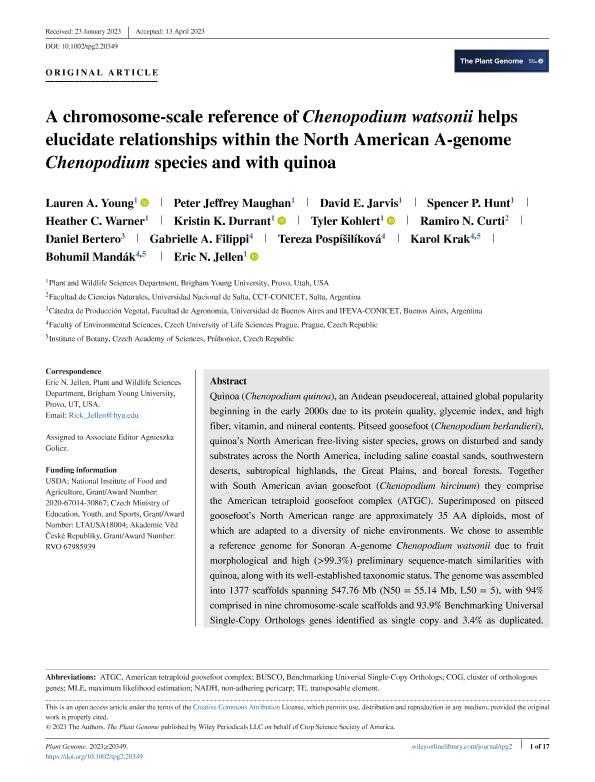Mostrar el registro sencillo del ítem
dc.contributor.author
Young, Lauren A.
dc.contributor.author
Maughan, Peter Jeffrey
dc.contributor.author
Jarvis, David E.
dc.contributor.author
Hunt, Spencer P.
dc.contributor.author
Warner, Heather C.
dc.contributor.author
Durrant, Kristin K.
dc.contributor.author
Kohlert, Tyler
dc.contributor.author
Curti, Ramiro Nestor

dc.contributor.author
Bertero, Hector Daniel

dc.contributor.author
Filippi, Gabrielle A.
dc.contributor.author
Pospíšilíková, Tereza
dc.contributor.author
Krak, Karol
dc.contributor.author
Mandák, Bohumil
dc.contributor.author
Jellen, Eric N.
dc.date.available
2023-12-01T15:28:34Z
dc.date.issued
2023-05
dc.identifier.citation
Young, Lauren A.; Maughan, Peter Jeffrey; Jarvis, David E.; Hunt, Spencer P.; Warner, Heather C.; et al.; A chromosome-scale reference of Chenopodium watsonii helps elucidate relationships within the North American A-genome Chenopodium species and with quinoa; Wiley; The Plant Genome; 16; 3; 5-2023; 1-17
dc.identifier.issn
1940-3372
dc.identifier.uri
http://hdl.handle.net/11336/219013
dc.description.abstract
Quinoa (Chenopodium quinoa), an Andean pseudocereal, attained global popularity beginning in the early 2000s due to its protein quality, glycemic index, and high fiber, vitamin, and mineral contents. Pitseed goosefoot (Chenopodium berlandieri), quinoa's North American free-living sister species, grows on disturbed and sandy substrates across the North America, including saline coastal sands, southwestern deserts, subtropical highlands, the Great Plains, and boreal forests. Together with South American avian goosefoot (Chenopodium hircinum) they comprise the American tetraploid goosefoot complex (ATGC). Superimposed on pitseed goosefoot's North American range are approximately 35 AA diploids, most of which are adapted to a diversity of niche environments. We chose to assemble a reference genome for Sonoran A-genome Chenopodium watsonii due to fruit morphological and high (>99.3%) preliminary sequence-match similarities with quinoa, along with its well-established taxonomic status. The genome was assembled into 1377 scaffolds spanning 547.76 Mb (N50 = 55.14 Mb, L50 = 5), with 94% comprised in nine chromosome-scale scaffolds and 93.9% Benchmarking Universal Single-Copy Orthologs genes identified as single copy and 3.4% as duplicated. A high degree of synteny, with minor and mostly telomeric rearrangements, was found when comparing this taxon with the previously reported genome of South American C. pallidicaule and the A-subgenome chromosomes of C. quinoa. Phylogenetic analysis was performed using 10,588 single-nucleotide polymorphisms generated by resequencing a panel of 41 New World AA diploid accessions and the Eurasian H-genome diploid Chenopodium vulvaria, along with three AABB tetraploids previously sequenced. Phylogenetic analysis of these 32 taxa positioned the psammophyte Chenopodium subglabrum on the branch containing A-genome sequences from the ATGC. We also present evidence for long-range dispersal of Chenopodium diploids between North and South America.
dc.format
application/pdf
dc.language.iso
eng
dc.publisher
Wiley
dc.rights
info:eu-repo/semantics/openAccess
dc.rights.uri
https://creativecommons.org/licenses/by-nc-sa/2.5/ar/
dc.subject
CHENOPODIUM
dc.subject
PHYLOGENY
dc.subject
CHROMOSOME SCALE
dc.subject
NORTH AMERICA
dc.subject.classification
Bioquímica y Biología Molecular

dc.subject.classification
Ciencias Biológicas

dc.subject.classification
CIENCIAS NATURALES Y EXACTAS

dc.title
A chromosome-scale reference of Chenopodium watsonii helps elucidate relationships within the North American A-genome Chenopodium species and with quinoa
dc.type
info:eu-repo/semantics/article
dc.type
info:ar-repo/semantics/artículo
dc.type
info:eu-repo/semantics/publishedVersion
dc.date.updated
2023-11-28T15:04:31Z
dc.identifier.eissn
1940-3372
dc.journal.volume
16
dc.journal.number
3
dc.journal.pagination
1-17
dc.journal.pais
Estados Unidos

dc.description.fil
Fil: Young, Lauren A.. Brigham Young University; Estados Unidos
dc.description.fil
Fil: Maughan, Peter Jeffrey. Brigham Young University; Estados Unidos
dc.description.fil
Fil: Jarvis, David E.. Brigham Young University; Estados Unidos
dc.description.fil
Fil: Hunt, Spencer P.. Brigham Young University; Estados Unidos
dc.description.fil
Fil: Warner, Heather C.. Brigham Young University; Estados Unidos
dc.description.fil
Fil: Durrant, Kristin K.. Brigham Young University; Estados Unidos
dc.description.fil
Fil: Kohlert, Tyler. Brigham Young University; Estados Unidos
dc.description.fil
Fil: Curti, Ramiro Nestor. Universidad Nacional de Salta. Facultad de Ciencias Naturales; Argentina. Consejo Nacional de Investigaciones Científicas y Técnicas. Centro Científico Tecnológico Conicet - Salta; Argentina
dc.description.fil
Fil: Bertero, Hector Daniel. Universidad de Buenos Aires. Facultad de Agronomía. Departamento de Producción Vegetal. Cátedra de Producción Vegetal; Argentina. Consejo Nacional de Investigaciones Científicas y Técnicas. Oficina de Coordinación Administrativa Parque Centenario. Instituto de Investigaciones Fisiológicas y Ecológicas Vinculadas a la Agricultura. Universidad de Buenos Aires. Facultad de Agronomía. Instituto de Investigaciones Fisiológicas y Ecológicas Vinculadas a la Agricultura; Argentina
dc.description.fil
Fil: Filippi, Gabrielle A.. Brigham Young University; Estados Unidos
dc.description.fil
Fil: Pospíšilíková, Tereza. Brigham Young University; Estados Unidos
dc.description.fil
Fil: Krak, Karol. Brigham Young University; Estados Unidos
dc.description.fil
Fil: Mandák, Bohumil. Brigham Young University; Estados Unidos
dc.description.fil
Fil: Jellen, Eric N.. Brigham Young University; Estados Unidos
dc.journal.title
The Plant Genome
dc.relation.alternativeid
info:eu-repo/semantics/altIdentifier/url/https://acsess.onlinelibrary.wiley.com/doi/10.1002/tpg2.20349
dc.relation.alternativeid
info:eu-repo/semantics/altIdentifier/doi/http://dx.doi.org/10.1002/tpg2.20349
Archivos asociados
